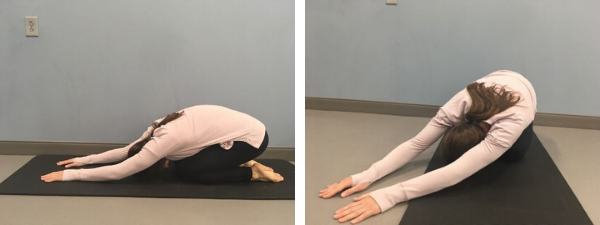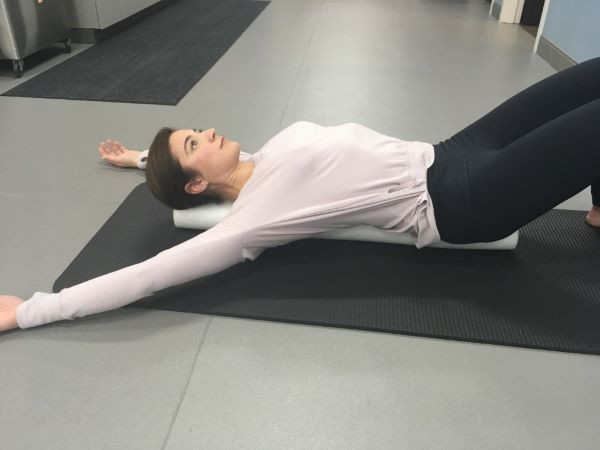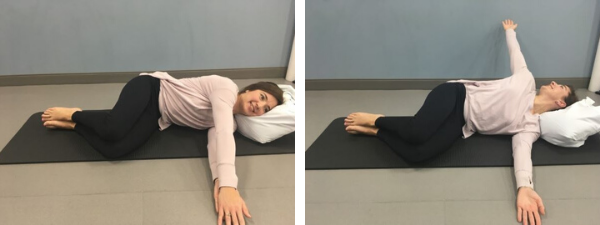
Full body, low impact, sweat free –- swimming checks a lot of boxes that make it an ideal workout for any fitness level. For all its benefits, however, swimming can cause discomfort and even pain due to a common culprit: muscle tightness.
OrthoCarolina Physical Therapy Assistant Mary Jean McKinnon is all too familiar with muscle tightness, both personally and professionally. During her time as a former swimmer, Mary Jean experienced painfully tight muscles that hindered her performance in the pool and made proper rest and recovery difficult. To make matters worse, her muscle tightness only escalated as her practice hours and intensity increased.
Through her physical therapy practice, today Mary Jean helps her patients relieve their tight muscles by reducing the overuse of certain muscle groups, not only enhancing athletic performance but also supporting more effective and enjoyable rest. The stretches and techniques below target specific muscles to help swimmers of all ages perform their best.
MUSCLES TARGETED: UPPER TRAPEZIUS
Spanning from the neck to the shoulder blades, the trap muscles tighten when swimmers reach past their natural arm length to increase their stroke length. To decrease repetitive overuse of the traps, reach only the distance of your arm, allowing for a more efficient stroke and reduced pain.
Stretch: Head Tilt
- Tilt your head to one side and allow gravity to gently pull your head down, with your ear toward your shoulder.
- Ensure your shoulders remain heavy and relaxed.
- Repeat on the other side.

MUSCLES TARGETED: lATISSIMUS DORSI
Located on the sides of the mid back, the lat muscles are used to complete most swim strokes. While using your lats is unavoidable in swimming, strengthening your hip and core muscles can make your swim strokes more efficient, in turn reducing reliance on the lat muscles.
If you find your lats become tighter than what’s comfortable, opt for increasing the number of kick sets. Shift your focus to another part of your stroke to swim faster and enhance your workout.
Stretch: Child’s Pose
- Begin on your hands and knees and push your hips backward onto your heels.
- From this kneeling position lower your chest toward the ground and extend your arms forward on the mat, allowing your thighs and the mat to support the front of your body.
- Walk your hands to one side of the mat, stretching out the lats on the opposite side of your body.
- Repeat on the other side.

Stretch: Pin Wheel
- Lie on one side with your knees bent toward your chest.
- Extend both arms straight out at shoulder height and gently reach your top arm further forward.
- Then slowly lift your top arm to begin arching upward toward your head.
- Move your arm in a moon shape starting from the front of your body, then over your head and back toward your hips.
- Slowly return to the starting position and repeat. With each arch, pause at the tight region and breathe deeply and slowly.
- Repeat on the other side.

MUSCLES TARGETED: PECTORAL
Tightness in the pectoral muscles is common in swimmers as the pec major muscle helps perform correct stroke technique. To give your upper body a break and to improve overall efficiency in the water, try increasing the number of kick sets. You may kick on your side and back as well as on your stomach to both provide a different challenge and promote kicking in the different positions of your stroke. (Elite swimmers rotate from side to side while swimming.)
Stretch: T Stretch with Foam Roll
- Recline on the foam roll with it directly underneath your spine, so it supports your tailbone and head.
- Bring your arms outward into a T position to stretch the front of your chest.

If the pec minor muscle is tight, you may be digging into the water too much to compensate for upper-extremity weakness. Remember, you can only move as fast as the correct technique will take you. Otherwise, you’re signing up for an injury. To minimize overusing pec minor, keep your shoulder blades back while swimming – no hunched-over-your-desk posture in the pool.
Stretch: Y Stretch with Foam Roll
- Recline on the foam roll with it directly underneath your spine, so it supports your tailbone and head.
- Place your arms in a Y position and allow the small muscle from your chest to arm to relax.

MUSCLES TARGETED: sHOULDER bLADES, tHORACIC sPINE, rIBCAGE
While swimming demands significant use of the upper body, it does not require much bending of the thoracic spine, or upper back. As a result, swimmers’ shoulder blades often lack mobility and the thoracic spine becomes stiff. This rigidness in the upper back and ribs can make breathing difficult.
Stretch: Telescope Arms
- Lie on one side with your knees bent toward your chest.
- Extend both arms straight out at shoulder height and gently reach your top arm further forward, stretching the back of your shoulder blades.
- Then glide your top arm across and behind your body to reach toward your backside. Keep your bottom arm pressed to the ground.
- Pause at areas of tightness and breathe deeply and slowly.
- Repeat on the other side.

Pinwheel is also useful to stretch the shoulder blades, thoracic spine and ribcage. See the step-by-step instructions above.
MUSCLES TARGETED: lUMBAR sPINE
Although the spine remains stable and stiff in most swim strokes, mobility is an important indicator of spine health. Cat Camel stretch and Swan stretch promote spinal mobility in multiple directions while utilizing breath and activating your abdominal muscles.
Stretch: Cat Camel Stretch
- Begin on your hands and knees with hands underneath your shoulders and knees underneath your hips.
- Keep your arms straight and pull your shoulders down, away from your ear lobes.
- Engage your abdominal muscles to stretch the lumbar spine upward. Exhale slowly as your spine rounds.
- Return to a flat-back position and repeat the stretch.

Stretch: Swan Stretch
- Begin by lying on your stomach.
- Place your hands beside your shoulders and hug your elbows in toward your ribs.
- Gently lift up your torso by pushing your hands into the floor, stretching your abdomen, back and hips.
- Keep your head lifted and neck relaxed while pulling your shoulders down, away from your ear lobes.

MUSCLES TARGETED: gLUTEAL, pIRIFORMIS, qUADRICEPS
The gluteal and piriformis muscles span the back of the hips, and the quadriceps muscles run along the thigh. These areas frequently become tight when swimmers kick too much or lack the upper-body or core strength to balance the lower body’s efforts.
In addition to stretching the glutes, piriformis and quads, building strength in your upper body and abdomen can help relieve tightness in your hips and thighs. You can improve speed and give your lower extremities a breather by adding a pull set. To rest the quads during your swimming workout, add in an upper-extremity (UE) set, perhaps with paddles and a pull buoy for an aggressive upper-body workout. Pilates is an effective workout to improve core strength.
Stretch: Figure Four Stretch
- Lie on your back and bend your knees to place your feet flat on the floor, with your heels close to your hips.
- Cross one ankle over the opposite knee.
- Lace your hands behind the thigh of your grounded leg and lift up this leg to stretch the back of the hip.
- Repeat on the other side.

Stretch: Quadriceps Stretch
- Lie on your stomach with your legs extended.
- Lift one heel toward your hips and grab your ankle, gently pulling your ankle toward your hip to stretch the front of your thigh.
- Slowly return to the starting position and repeat on the other side.

Mary Jean McKinnon, PTA, is a physical therapy assistant.
Comments
August 14, 2023
Back




September 15, 2024